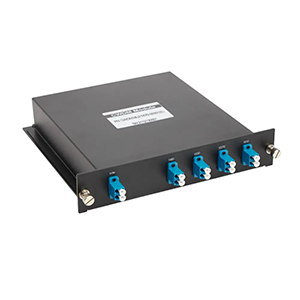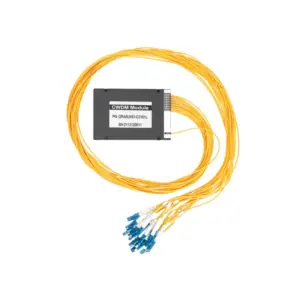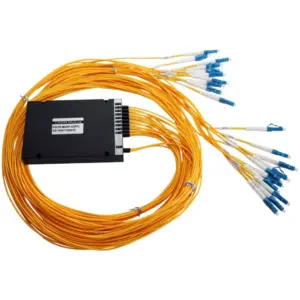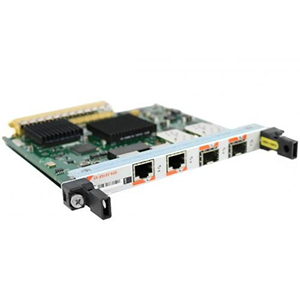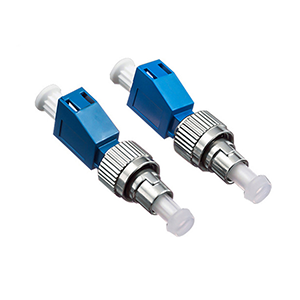Welcome to this blog! I will introduce you to the importance and popularity of Wavelength Division Multiplexing (WDM) technology in the communications field, and discuss in detail the main advantages and benefits of WDM technology. By understanding the basic principles and workings of WDM technology, you will learn how it improves network bandwidth utilization, expands data capacity, and provides flexibility and cost-effectiveness.
Review of the basic principles of WDM technology
Wavelength Division Multiplexing (WDM) technology is a multiplexing technology used in optical fiber communication systems. Its basic principle is to improve bandwidth utilization by transmitting multiple optical signals of different wavelengths simultaneously. The following is a brief review of the basic principles and workings of WDM technology.
The basic principle of WDM technology is to use different wavelengths (colors) of light to achieve multiplexing. In fiber optic transmission, each wavelength can be regarded as an independent communication channel. WDM systems achieve multiplexing by simultaneously transmitting multiple optical signals of different wavelengths in optical fibers and combining them for transmission.
WDM systems usually contain two key components: fiber optic transceivers and fiber optic multiplexers/demultiplexers.
-
Fiber optic transceiver:
Fiber optic transceivers are devices used to send and receive optical signals. It contains multiple lasers and optical receivers, each corresponding to a specific wavelength channel. Fiber optic transceivers convert electrical signals into optical signals of specific wavelengths and send them down optical fibers. Likewise, it can also receive optical signals from optical fibers and convert them into electrical signals for processing.
-
Fiber optic multiplexer/demultiplexer:
Fiber optic multiplexers/demultiplexers are devices used to multiplex and demultiplex optical signals. It is responsible for combining the optical signals of multiple wavelength channels into one optical fiber for transmission, or parsing the optical signals of each wavelength channel from the optical fiber. Fiber optic multiplexers/demultiplexers allow multiple communication channels to share the same fiber and ensure that they do not interfere with each other.
WDM technology simultaneously transmits multiple optical signals of different wavelengths and combines them in one optical fiber for transmission. This can greatly improve the bandwidth utilization of optical fiber communication systems. Each wavelength channel can carry an independent data stream, so the WDM system can transmit multiple independent communication channels at the same time to achieve high-speed, high-bandwidth data transmission.
The advantage of WDM technology is that it allows multiple communication channels to share the same optical fiber, thereby greatly improving bandwidth utilization. Compared with traditional single-wavelength communication systems, WDM technology can transmit multiple times the amount of data in the same optical fiber. This is critical to meeting growing data demands and increasing the capacity and efficiency of communications systems.
WDM technology realizes the multiplexing of optical fiber communication systems by transmitting multiple optical signals of different wavelengths simultaneously. Its basic principle is to combine multiple independent communication channels for transmission, thereby improving bandwidth utilization and system capacity. This makes WDM technology one of the key technologies widely used in modern optical fiber communication systems.
Bandwidth expansion and capacity increase
Wavelength Division Multiplexing (WDM) technology has major advantages in expanding network bandwidth and increasing data transmission capacity. By using multiple wavelengths in optical fiber for parallel transmission, WDM technology can significantly increase data transmission speed and capacity. Here’s an explanation of these benefits:
-
Bandwidth expansion:
WDM technology simultaneously transmits multiple optical signals of different wavelengths and combines them in one optical fiber for transmission. This parallel transmission method can expand the bandwidth of optical fiber. Each wavelength channel can carry an independent data stream, so the WDM system can transmit multiple independent communication channels at the same time to achieve high-speed, high-bandwidth data transmission. Compared with traditional single-wavelength communication systems, WDM technology can transmit multiple times the amount of data in the same optical fiber, thereby significantly expanding the bandwidth of the network.
-
Capacity increase:
By using multiple wavelengths for parallel transmission, WDM technology can increase the capacity of data transmission. Each wavelength channel can transmit data independently, so a WDM system can handle multiple independent data streams simultaneously. In this way, WDM technology can improve the throughput and capacity of data transmission. Transmission capacity can be further increased by increasing the number of wavelengths used. Compared with single-wavelength communication systems, WDM technology can achieve a substantial increase in capacity without increasing the number of optical fibers, thereby meeting the growing data demand.
-
Parallel transmission:
The advantage of WDM technology is its ability to use multiple wavelengths in optical fiber for parallel transmission. Traditional single-wavelength communication systems can only transmit data packets one by one, limiting the speed and capacity of data transmission. WDM technology can transmit data on multiple wavelength channels at the same time to achieve parallel transmission. As a result, the data transmission speed is significantly improved, and data packets can be transmitted at a higher rate, thus improving the efficiency and response time of data transmission.
WDM technology has major advantages in expanding network bandwidth and increasing data transmission capacity. By using multiple wavelengths in optical fiber for parallel transmission, WDM technology can increase data transmission speed and capacity to meet growing data demands. This makes WDM technology a key technology in modern optical fiber communication systems, providing a reliable and scalable solution for high-speed, high-bandwidth data transmission.
Flexibility and scalability
Wavelength Division Multiplexing (WDM) technology provides flexibility and scalability in network design and expansion. The following is a discussion of these aspects:
-
Flexibility:
WDM technology provides flexibility in network design because it can transmit multiple optical signals of different wavelengths simultaneously. This means that within the same optical fiber, multiple independent communication channels can be accommodated. This flexibility enables network designers to configure and allocate wavelength channels based on specific needs and application scenarios. According to different needs, you can choose to use specific wavelength channels for data transmission. This flexibility allows the network to adapt to different data traffic and communication needs, providing customized solutions.
-
Scalability:
WDM technology is scalable and can expand the network according to needs. By adding or subtracting wavelengths in a wavelength division multiplexer, the capacity and demand of the network can be adjusted. Increasing the number of wavelength channels increases the network’s transmission capacity to meet growing data demands. Conversely, if network capacity no longer needs to be as large, the number of wavelength channels can be reduced, thereby saving resources and accommodating smaller demands. This scalability enables the network to dynamically adjust and optimize based on actual conditions, improving resource utilization and reducing costs.
By flexibly configuring and adjusting wavelength channels, WDM technology can meet network designs of different sizes and needs. Whether it is expanding large-scale backbone networks or providing customized solutions, WDM technology can provide flexibility and scalability. This enables the network to adapt to changing communication needs and provide efficient and reliable data transmission and communication services.
WDM technology is flexible and scalable in network design and expansion. By transmitting optical signals of multiple wavelengths simultaneously and configuring and adjusting them according to needs, WDM technology can provide customized solutions to meet network requirements of different sizes and needs. This makes WDM technology one of the important technologies for building flexible and scalable networks.
Fiber utilization and cost effectiveness
Wavelength Division Multiplexing (WDM) technology has advantages in improving fiber utilization and reducing communication costs. Below is an explanation of these aspects:
-
Improving fiber utilization:
WDM technology transmits multiple optical signals of different wavelengths in optical fibers and combines them in one optical fiber for transmission. This parallel transmission method significantly improves fiber utilization. Compared with traditional single-wavelength communication systems, WDM technology can transmit multiple times the amount of data in the same optical fiber. By transmitting multiple signals simultaneously, the bandwidth of the optical fiber is more fully utilized, thereby improving the utilization rate of the optical fiber. This means that more data can be transmitted in the same number of optical fibers, achieving higher data throughput.
-
Reduction in communication costs:
WDM technology can reduce the number of optical fibers required and equipment costs by transmitting multiple signals in optical fibers. Traditional single-wavelength communication systems require the use of separate optical fibers for each communication channel, which results in extensive fiber usage and corresponding costs. Using WDM technology, multiple communication channels can be transmitted in the same optical fiber through optical signals of different wavelengths, thereby reducing the number of optical fibers required. In this way, network operators can save on fiber deployment and maintenance costs. In addition, due to the use of shared optical fiber infrastructure, WDM technology can also reduce the space and resources required for optical fiber cabling, further reducing communication costs.
WDM technology has advantages in improving fiber utilization and reducing communication costs. By transmitting multiple signals in optical fibers, WDM technology can improve fiber utilization and achieve higher data throughput. At the same time, WDM technology can reduce the construction and operating costs of communication infrastructure by reducing the number of required optical fibers and equipment costs. This makes WDM technology a cost-effective choice, providing network operators with competitive communications solutions.
Summary
Thank you for reading this blog. I hope you will have a deeper understanding of the importance and main advantages of Wavelength Division Multiplexing (WDM) technology in the communications field. WDM technology has become an indispensable key technology in modern communication systems, providing efficient and reliable communication solutions for our daily life and business activities.
When you choose our products, you will get advanced WDM technical support, which will bring huge improvements to your communication network. Our solutions provide high-bandwidth, high-capacity, flexible, scalable and cost-effective communications connectivity to meet your growing communications needs.
WDM Technology FAQ
Lorem ipsum dolor sit amet, consectetur adipiscing elit, sed do eiusmod tempor incididunt ut labore et dolore magna aliqua. Ut enim ad minim veniam, quis nostrud exercitation ullamco laboris nisi ut aliquip ex ea commodo consequat.
Lorem ipsum dolor sit amet, consectetur adipiscing elit, sed do eiusmod tempor incididunt ut labore et dolore magna aliqua. Ut enim ad minim veniam, quis nostrud exercitation ullamco laboris nisi ut aliquip ex ea commodo consequat.
WDM Related Products
-
100G QSFP28 CWDM 1271nm 2km LC Optical Transceiver
-
100G QSFP28 CWDM Single Lambda Optical Transceiver
-
100G QSFP28 CWDM4 1310nm 2km Optical Transceiver
-
16 Channel CWDM Module
-
18 Channel CWDM Module
-
200G QSFP56 PAM4 CWDM4 2km Transceiver Module
-
25G SFP28 CWDM 1270nm 10km Transceiver Module
-
2x100G QSFP-DD CWDM4 10km Transceiver Module
-
2x100G QSFP-DD CWDM4 2km Transceiver Module

